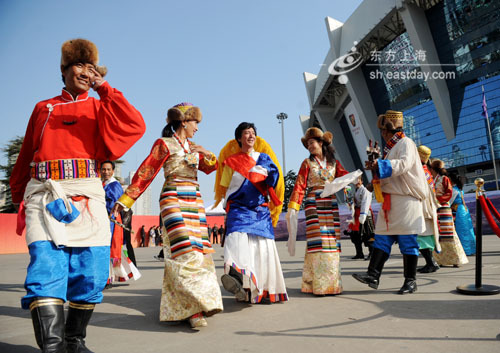On the vast and mystery Qinghai-Tibet Plateau, there is the Tibetan rock band "Tianchu" that demonstrates well its feelings and understandings of music with a combination of rock and roll, traditional Tibetan culture and candid expressions.
Like the band, many young Tibetans, proficient both in Tibetan and Chinese languages, are infusing new vigor into the inheritance and development of Tibetan culture in their own ways.
Charm of traditional Tibetan culture
In the 1990s, a song by a Tibetan artist, telling a story of her dumb sister in Tibet, caught people's great interest and also placed the ancient Tibetan culture to people in a modern way.
|

|
|
In this picture taken on March 3, 2009 Tibetan young people in Xigaze area rehearse a traditional Tibetan dance drama which will be televised on the Tibet Autonomous Region TV. |
With the advancing of modernization, many young Tibetans have long been studying, working or living in inland Chinese cities. The combination of traditional and modern Tibetan culture can be seen in their daily life, thus Tibetan culture is known to more people.
Tibetan culture has drawn people's attention in various forms.
Now Tibetan literature enters its peak period. On Tibetan Literature Website, a portal for Tibetan literature, there is section for modern Tibetan literature along with traditional literature, like ballads, myths, and epics. There are works by famous modern Tibetan poets, for instance, Alai, Zhaxi Dawa and Yidancai.
Bloggs, modern carrier of writing, is also becoming a platform for communications among young Tibetans. In December 2008, the Himalaya Tibetan blog, designed by the Tibetan Language Website, was put into use, which formally integrated the Tibetan blog platform with the international standard coding.
More exchanges and communications
Tibetan Culture Exchange Union, set up by Central University of Nationalities, aims to introduce Tibetan culture to more students on campus. Members of the union participate in various activities on campus, like dancing and singing, to promote their culture.
Many of the young Tibetan students arrive to study in inland at a young age. However, in them, the ancient Tibetan culture and modern pop culture blend with each other and exist in harmony.
They speak fluent Chinese and dress not much different from their inland peers, also embracing affection for fashion and passion for music. On campus, they communicate with inland students, introducing Tibetan culture while taking in inland culture.
Inheritance and development
A Tibetan culture themed store in Beijing's Chaoyang District draws lots of customers, both Chinese and foreign. Noticeable for a large prayer wheel, thangkas on all walls, masks for Tibetan opera and melodious Tibetan music, there are all kinds of Tibetan products, for example, Tibetan furniture, clothing, accessories, handcrafts and books.
There are also handmade crafts from Tibet as well as works created by professional designers. Lamu, owner of the store, said the crafts made in Tibet are becoming much more modern. While persevering the unique Tibetan culture, they add modern elements into them.
In recent years, a series of events promoting Tibetan culture have helped spread Tibetan culture. After the "Tibetan Riddle," a Tibet dance, was staged, a lot of customers place orders for tangkas featuring the heroine in the dance, said Lamu.
The unique charm of Tibetan culture comes from the integration of both Tibetan and Buddhist cultures, added the shop owner. Although many people are attracted to the mystery of Tibetan culture, it is, in fact, very close to daily life.
"We should understand Tibetan culture properly, to get to know its true meaning with our heart."
As to how to inherit and develop Tibetan culture and find a junction between ancient and modern times, Lamu said Tibetan culture itself is developing, therefore, an effective way to protect and inherit it is to let it develop by itself and create more ways for its transmission.
(Xinhua News Agency March 27, 2009)